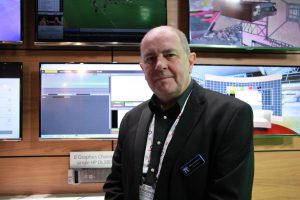IBC Q&A: RT Software’s Mike Fredriksen discusses the world of virtualisation and IP
 At RT Sofware’s stand at IBC 2016, Commercial Director Mike Fredriksen discussed the latest graphics developments and the ongoing shift in the direction of system virtualisation, web-based control, and IP…
At RT Sofware’s stand at IBC 2016, Commercial Director Mike Fredriksen discussed the latest graphics developments and the ongoing shift in the direction of system virtualisation, web-based control, and IP…
Can you tell us about one of the main aspects of your presence at IBC 2016?
With graphics overlay, we partner with some big players like SAM, who embed our graphics in their PC-based solution, specifically with ICE. That partnership has taken us into some big projects with the likes of Ericsson, Channel 5, and the BBC. Those guys are talking about requirements with multiple units, and they want to virtualise those channels so they can switch them on and off quickly [and] have redundancy and a small footprint in the rack space.
So this is driving a shift to virtualisation?
Yes. They wanted to virtualise our products, and that’s what we have here at IBC: our products running in a virtualised environment. We have an HP DL380 server with eight\ independent channels of live graphics running on a PC, which is pretty good.
In order to control and drive those graphics, they can be run through an automation system such as Morpheus or manually.
We have made the control completely web-based. You can have multiple web pages controlling a single platform with an operator driving the sports content and another driving the social media on the ticker, and they can be based anywhere. We see this very much as the future of graphics.
How are you approaching the introduction of IP?
These systems are running a mixture of SDI and IP, so it is completely scalable. As a hybrid, you can turn services on and off, and it is very easy to configure on the fly and add channels into it. It achieves all the objectives that these big customers wanted to hit.
How do you see the balance between SDI and IP shifting?
We are in a transitional period. IP is very new, and people are anxiously looking at the standards. So we have adopted several standards ourselves. But the sooner that we get clarity on the standards, the better.
You have two IPs really, so it is complicated. You have IP in the live-production environment, where the issues of latency and being able to switch [are] really crucial. Then [there is] IP on the delivery side, which is about compression and being efficient over distribution points. We are delivering what the market is demanding, but it is not efficient to be supplying multiple standards. We will do it because we are a software company supplying whatever the needs. But all we really want is standards, so that customers can get guaranteed interoperability. We see IP as a huge growth area, and, to put it simply, a lot of our development work is centred around IP. But most of our deliveries are centred around SDI.
